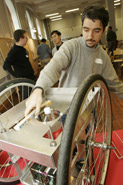"Cool" research sizzles
Ice: for many it is a slippery hazard, for others a building material or a source of life, and for some McGill professors, it is a research topic. Some of their work was presented at an event called Extreme Research: Winter Edition, held on February 15.

Jacques Hurtubise, vice-principal (research) sits on top of the environmentally friendly electric snowmobile.
Owen Egan
Architecture professor Pieter Sijpkes enjoys the challenge of building unique structures out of ice and snow: in the past, these have included free-standing ice arches, various igloo-like structures and an interpretation of the pantheon in Rome that accommodated 128 people. This year he and his students were keen to build a fractal snow palace to host the Extreme Research event. Plans were made and sugar cube models were built. They even lined up a donation of 4,000 milk crates to be used as forms. Unfortunately, they were faced with an unbeatable and rather unusual challenge for a Montreal winter - lack of snow - which forced the event inside the Macdonald-Harrington Building

Alessio Salemo, doctoral student at the Centre for Intelligent Machines, shows off a gizmo designed to act as a waiter for wheelchair users at the touch of a joystick or push of a button.
Owen Egan
According to geography professor Wayne Pollard, 50 percent of Canada is frozen, and some of the ice is more than one kilometre thick. His research team is characterizing this massive ground ice and the perennial springs in the far North. They will determine the age, origin and significance of the massive ice and how climate change will affect these Arctic landscapes. He is also working with colleagues from NASA to use his data to model the permafrost on Mars. This will lead to a description of the past climates of Mars and the methods to search for water and life on that planet.
For civil engineering professor Saeed Mirza, the process of water freezing creates havoc with our infrastructure. We see the evidence in the near-legendary potholes that spring up uninvited throughout our city streets. He is worried about the weaknesses of not only our roads, but also our sidewalks, bridges, ports, water distribution systems and sewers. This spring his students will examine over 1,000 potholes. Their findings will lead to a better understanding of what causes deterioration in concrete structures and how they can be built to last.
According to meteorologist Ron Stewart, Montreal is the top city in Canada when it comes to ice pellet precipitation. With his enthusiastic team of undergraduate and graduate students and postdoctoral researchers in the Department of Atmospheric and Oceanic Sciences, along with collaborators at Environment Canada, he is looking at extreme weather events, with a special focus on winter storms, such as the 1998 ice storm. They are developing and adapting sophisticated instruments such as the Precipitation Occurrence Sensing System (POSS) to study winter precipitation in its various forms - including freezing rain, ice pellets and snow - both in the lab and in the field.
Surprisingly, ice supports microscopic life. Environmental biologist Lyle Whyte is looking at the microbial communities that exist in a number of these high Arctic environments and how these organisms survive in the extrem cold. He is also translating this knowledge to determine if extraterrestrial microbes existed or are still present in other very cold environments, such as Mars or Europa (one of Jupiter's moons).
Harriet Kuhnlein and the team at the Centre for Indigenous Peoples Nutrition and Environ-ment (CINE) are looking at food sources in Northern communities. Although there are approximately 200 species of indigenous plants and animals available, some people opt instead for market or processed foods of low nutrient quality (high fat and high glycemic-index foods).
In this climate, the cold and winter weather are topics of unifying interest. The researchers working with Jorge Angeles, chair of the Design for Extreme Environments and the Centre for Intelligent Machines, are looking at robots and other machines to cope with extreme temperatures and terrains. The chair has helped fund an electric snowmobile project led by mechanical engineering student Simon Ouellette - a project that should ultimately lead to more environmentally friendly variations of other recreational vehicles as well.
About one in 20 of us becomes seriously depressed by the lack of sunlight during the winter months. Hani Iskandar of the Douglas Hospital is studying seasonal affective disorder, or SAD, and ways it can be treated, especially with light therapy. New lamps can provide effective relief from SAD within a few days, when used for less than an hour a day - which is extremely good news for the sun-starved.
The research showcased at Extreme Reseach: Winter Edition received funding from a number of sources, including the Natural Sciences and Engineering Research Council, the Canadian Institutes of Health Research, the Canada Research Chairs program, the Canada Foundation for Innovation and the Networks of Centres of Excellence.
